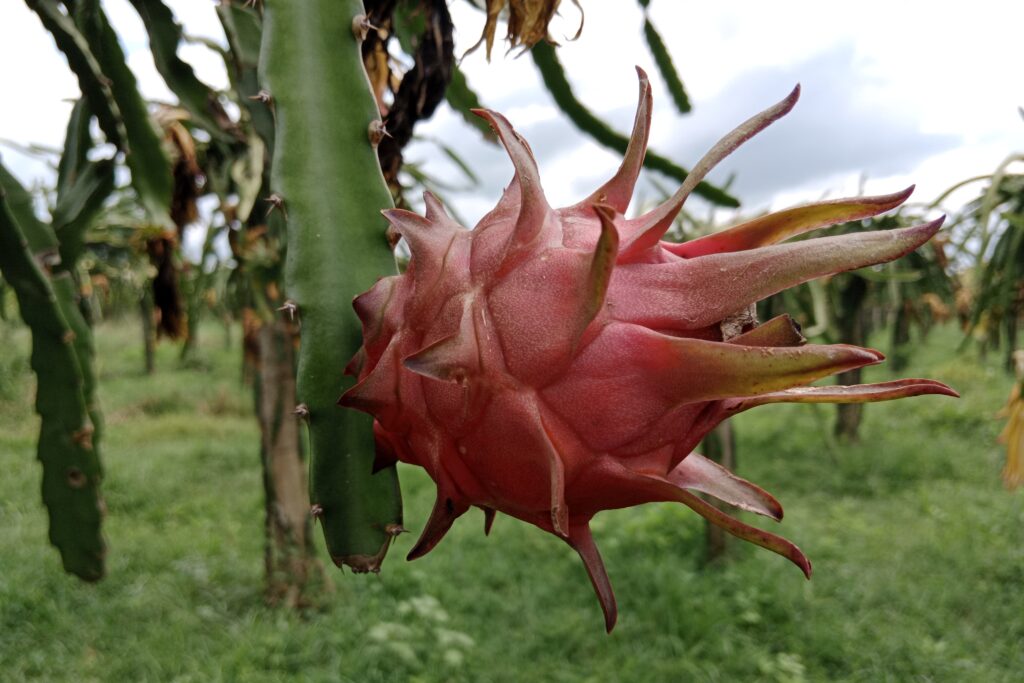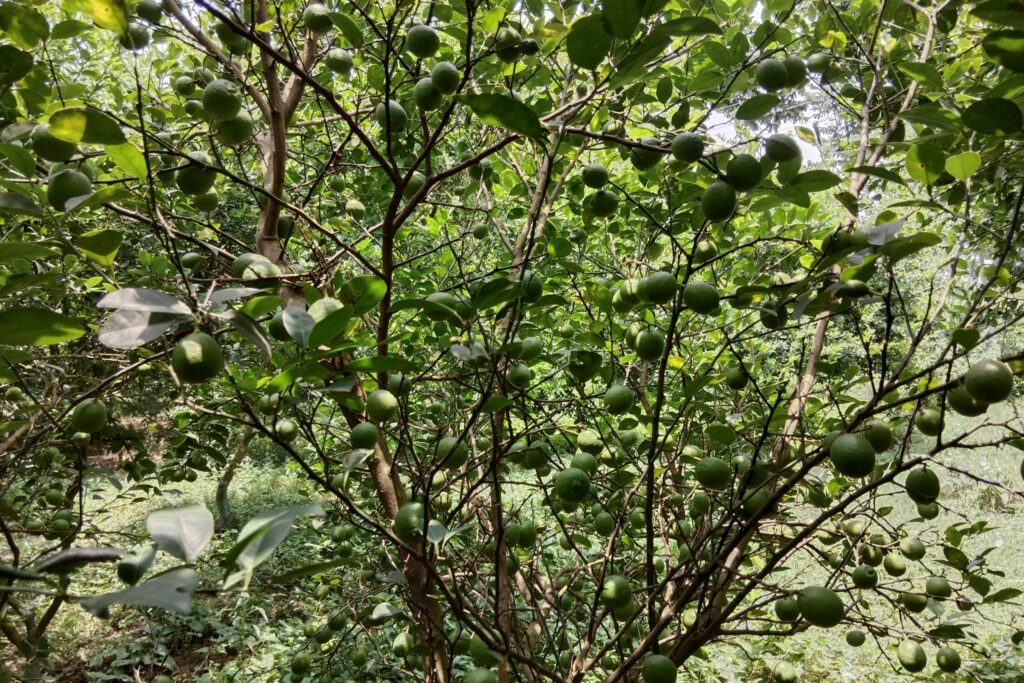Date Farming
Date palm farming profit per acre demonstrates significant potential over the crop’s 100-year lifespan, with cumulative income far surpassing cultivation costs. The total expenses, amounting to NRs. 7,780,000 per acre, includes an initial investment of NRs. 355,000 in the first year and recurring annual maintenance costs averaging NRs. 75,000 from Years 2–100.
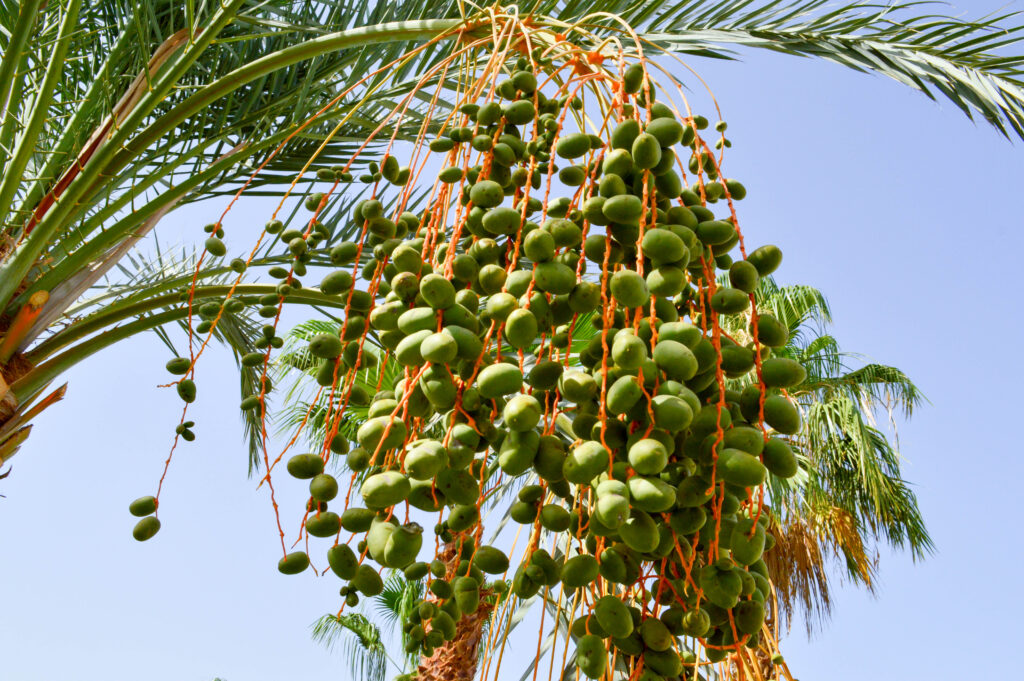
Revenue generation begins in Year 4 (NRs. 280,000) and accelerates through Years 5–7 (NRs. 2,520,000 total), Years 8–10 (NRs. 4,200,000 total), and peaks during the prime production phase in Years 11–50, contributing NRs. 107,520,000, or 65% of total income. Although yield gradually declines in Years 51–80 (NRs. 42,000,000 total) and Years 81–100 (NRs. 8,400,000 total), the cumulative revenue of NRs. 164,920,000 results in a remarkable net profit of NRs. 157,140,000 per acre, showcasing the profitability of this long-term agricultural investment.
Land Preparation
Land preparation begins with thorough clearing to remove all existing vegetation, rocks, and debris. This is followed by deep plowing (30-45 cm or deeper) to break up hardpans, significantly improve soil aeration, and enable deep root penetration, with laser leveling being crucial during this stage to ensure uniform water distribution, especially for flood or basin irrigation systems.
If soil compaction persists, subsoiling below the initial plow depth may be necessary to further enhance drainage and encourage root growth. Finally, harrowing is performed after plowing to create a fine, level soil tilth suitable for digging planting pits and supporting the initial growth of the date palms.
Soil Type
Date palms are highly adaptable to various soil textures, including sandy, sandy loam, loam, and clay loam, but thrive best in deep, well-drained sandy loam or loamy soils with excellent drainage, such as stagnant water or a high-water table (within 1-1.5m of the surface) can cause root asphyxiation and prove fatal.
While date palms tolerate saline and alkaline soils better than many crops, they perform optimally in soils with pH levels between 7 and 8.5. However, heavy, poorly drained clay soils or highly saline/sodic soil without substantial reclamation are unsuitable for their growth.
Climatic Requirements
| Climatic Factor | Requirements |
| Temperature | Hot, long summers are essential; optimal mean temperatures for fruit ripening: 30-35°C. Requires high heat units (long periods > 18°C, ideally > 30°C) for flowering, fruit set, and ripening. Mature trees can withstand brief frosts (-5°C to -7°C), but flowers and young fruit are damaged below 0°C. Winter chilling is not required. |
| Sunlight | Full, intense sunlight throughout the year is critical for productivity and fruit quality. |
| Humidity | Low relative humidity (<50-60%) during ripening is vital to prevent fruit spoilage, fungal issues, and ensure dry, storable dates. Higher humidity during pollination can be beneficial but increases disease pressure later. |
| Rainfall | Thrives in arid and semi-arid regions. Rainfall during flowering and ripening is detrimental, causing pollination failure and fruit rot/splitting. Ideal annual rainfall: < 100-150mm during critical periods. Irrigation is necessary in most regions. Wind protection (windbreaks) may be needed against hot, desiccating winds or storms. |
Major Cultivars
Date palm cultivars are broadly classified based on their moisture content and texture into soft, semi-dry, and dry categories:
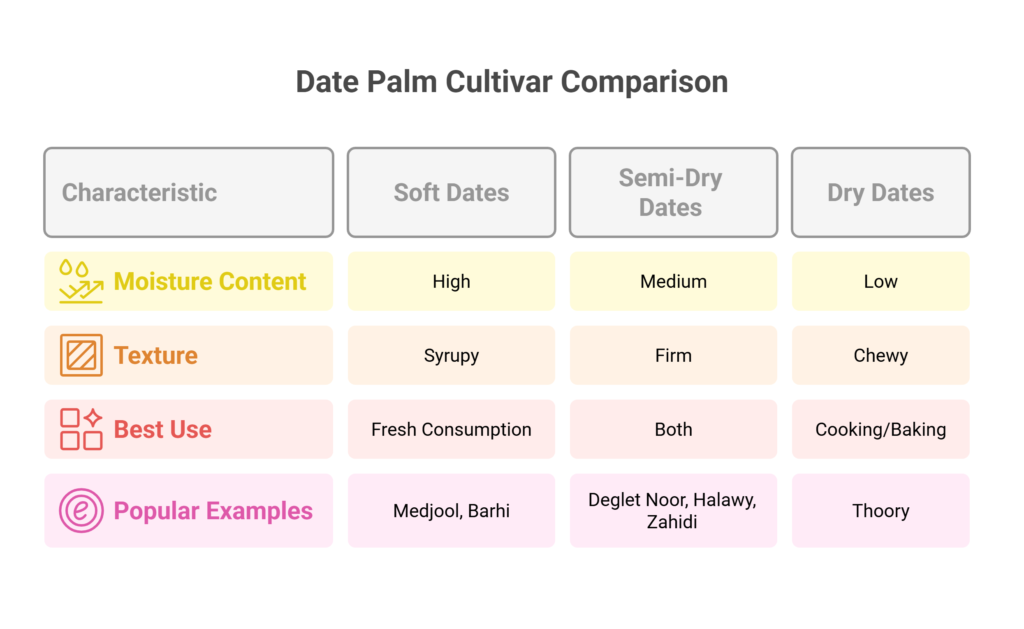
a). Soft Dates
These cultivars are characterized by their high moisture content and syrupy texture, making them highly prized for fresh consumption. Popular examples include Medjool, often referred to as the “King of Dates” for its large size and rich flavor, and Barhi, known for its unique versatility as it can be consumed fresh when yellow and crisp.
b). Semi-Dry Dates
These dates have a firmer texture and less moisture than soft dates, making them suitable for both fresh consumption and processing. Notable cultivars include Deglet Noor, celebrated as the “Queen of Dates” for its translucent amber appearance and mildly sweet flavor, as well as Halawy and Zahidi, which are renowned for their caramel-like taste and long shelf life.
c). Dry Dates
With very low moisture content, these cultivars are chewy and often used in cooking or baking. Thoory is a prime example, valued for its nutty flavor and suitability for long-term storage.
Planting
a). Planting Season
Date palms are generally planted in the spring, from February to April in the Northern Hemisphere, in order to avoid periods of frost and the extreme heat of the hottest part of the summer. Planting in the fall is also feasible in areas with mild winters.
b). Spacing
Planting is carried out using the square system, with spacing requirements varying significantly based on the cultivar’s vigor and the soil’s fertility:
| Vigor Category | Example Variety | Spacing (m) | Trees/Acre |
| Vigorous | Medjool | 8m × 8m | 27 – 40 |
| Moderate | Deglet Noor | 7m × 7m | 63 – 82 |
| Dwarfing | – | 6m × 6m | ~112 |
Wider spacing aids light penetration, air flow, and machinery access.
c). Pit Preparation
For date palm planting, large pits (typically 1m x 1m x 1m) should be dug well in advance, ranging from weeks to months before planting. The topsoil and subsoil are separated, and the pits are refilled with a mixture comprising topsoil, 10-15 kg of well-rotted farmyard manure (FYM), 100g of Trichoderma viridae, 100g of bone meal, and 1-2 kg of Single Super Phosphate (SSP) to enrich the soil and promote healthy growth.
d). Planting Method
Transplant the suckers into the main field.
Intercropping

| Aspect | Details |
| Feasibility | Primarily viable during juvenile phase (first 3-6 years), before canopy closure and root dominance. |
| Suitable Crops | Low-growing, shade-tolerant, non-competitive crops with shallow roots and short duration: – Vegetables: onions, garlic, leafy greens, brinjal, chilly – Legumes: beans, peas, guar gum – Herbs; fodder grasses; rice |
| First Harvest | 4-5 years required for initial date palm harvest. Intercrops (as listed) can be cultivated during juvenile phase. |
Irrigation
During summer, irrigation is provided every 10-15 days, while in winter, it is given every 30-40 days, with prior irrigation essential after spathe emergence and regular intervals required after fruit set. Common irrigation methods include basin, furrow, bubbler, and drip systems, with drip irrigation being the most efficient for water conservation and precise delivery. It is crucial to ensure water reaches the deep root zone (1.5m or more for mature trees), and salinity management through leaching may also be necessary.
Fertilizer and Manure
| Category | Details | |
| Compost | Organic matter is essential; apply 15-30 kg of well-rotted FYM or compost per mature tree annually, ideally before the growing season. | |
| Chemical Fertilizers | Nitrogen (N): 1.0 – 2.0 kg per tree annually, split into 2-3 applications during spring & summer. Phosphorus (P₂O₅): 0.5 – 1.0 kg per tree annually, often applied once early in the season. Potassium (K₂O): 1.5 – 3.0 kg per tree annually, split into multiple applications; improves fruit quality, size, sugar content, and disease resistance, with requirements increasing with yield. | |
| Micronutrients | Treat micronutrient deficiencies (Mg, Fe, Mn, Zn, B) via foliar sprays or soil application. | |
| Application | Broadcast fertilizers within the drip line and incorporate lightly or apply through fertigation. Time N and K applications to match growth phases and fruit development. | |
Weed Control
Weed management is crucial in date palm cultivation, primarily to reduce competition for water, nutrients, and light, which is especially critical for young palms. Methods include mechanical control through regular hoeing or cultivation around the tree base (taking care to avoid damaging shallow roots) to maintain a weed-free circle of 1-2m diameter.
Mulching with organic materials like compost or palm waste to suppress weeds, conserve soil moisture, and improve soil quality, ensuring the mulch is kept away from the trunk base; selective chemical control using pre-emergent or post-emergent herbicides, applied precisely according to label instructions to prevent tree damage (with particular caution for risky herbicides like glyphosate), often employing spot treatment for safety; and, in mature orchards with adequate spacing, the use of carefully managed cover crops to suppress weeds and enhance soil, though their competitive effects must be monitored.
Pest and Disease Management
Common Pests
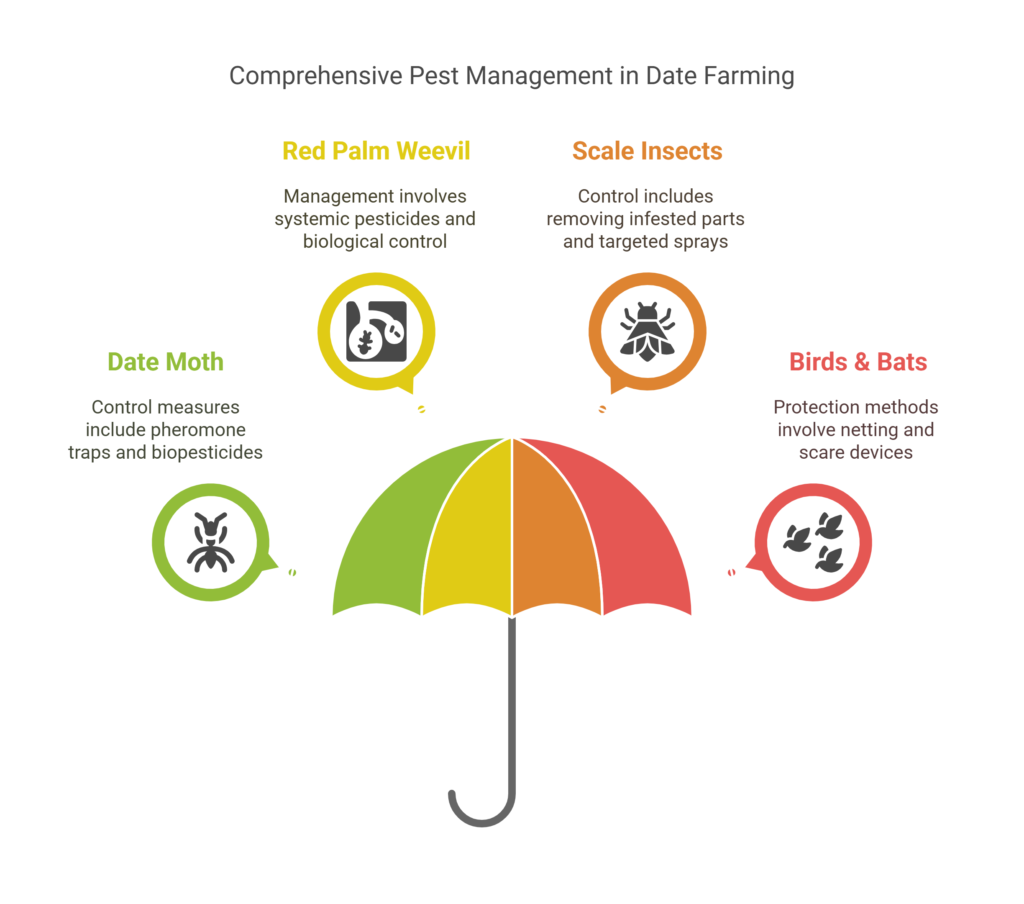
a). Date Moth
The date moth larvae bore into fruits and bunches, causing significant damage. Effective control measures include using pheromone traps, biopesticides like Bacillus thuringiensis (Bt), bunch bagging, sanitation, and insecticides. As a preventive measure, apply two sprays of Deltamethrin at a concentration of 2ml per liter of water, with a 15-day interval, starting at the fruit-bearing stage.
b). Red Palm Weevil
Date palms are seriously threatened by the Red Palm Weevil (Rhynchophorus ferrugineus), whose larvae penetrate trunks and cause lethal damage. Systemic pesticide trunk injections (sometimes with fungicides), biological control with entomopathogenic worms such as Steinernema carpocapsae, rigorous cleanliness by removing contaminated palms, and early identification with pheromone traps and acoustic probes are all components of effective management. Reducing pests and safeguarding orchards require an integrated strategy.
c). Scale Insects
To control scale insect infestations, immediately remove and destroy infested branches or leaves away from the field to prevent spreading. If active infestation persists, apply a targeted spray of either Acetamiprid at 60 grams per 100 liters of water or Imidacloprid at 60 milliliters per 100 liters of water.
d). Birds & Bats
Birds and bats pose a significant threat to date palm production by feeding on ripe fruit, particularly during the vulnerable doka stage (early ripening phase) when damage is most likely. Effective control strategies include physically protecting fruit through netting—either by covering individual bunches with thin wire mesh or netting entire trees—and employing scare devices (e.g., reflective tapes, sonic repellents) to deter pests. Bunch netting remains the most reliable preventative measure to safeguard the developing crop from direct feeding damage and spoilage.
Common Diseases
a). Alternaria leaf blight
Date palms can suffer significant damage from Alternaria leaf blight, a fungal disease that weakens the leaves and reduces the plant’s overall health. Using a solution of carbendazim and mancozeb at a rate of two grams per liter of water is essential for promptly eliminating infestation. This initial treatment helps to protect healthy foliage and stop the fungus from spreading. In order to ensure good management, maintain consistent coverage, and maximize the treatment’s efficacy, a second spray should be used 15 days later.
b). Fruit Rots
Excessive rainfall or humidity during the fruiting to maturity stages is a primary cause of fruit rot in date palms. To mitigate this, bunches should be covered with protective paper during the early khalal stage to shield them from moisture. Additionally, removing a few central fruit strands enhances ventilation and speeds up drying within the bunch. If signs of disease persist despite these measures, apply a spray of Mancozeb and Carbendazim at a concentration of 2 grams per liter of water to control the infestation effectively.
c). Graphiola Leaf Spot (False Smut)
Graphiola Leaf Spot (False Smut), caused by the fungus Graphiola phoenicis, is a common foliar disease in date palms that thrives under prolonged humid conditions, manifesting as distinctive fuzzy gray or brown pustules on both leaf surfaces that rupture to release spores; while rarely fatal, severe infections compromise photosynthesis and tree vigor. Effective control requires timely foliar spraying during humid periods with either Copper Oxychloride at 3 grams per liter of water or Mancozeb at 2 grams per liter, applied thoroughly to cover all foliage, with repeat applications every 14–21 days during high-risk weather to disrupt the fungal life cycle and prevent spore dispersal.
d). Inflorescence Rot
Control Inflorescence Rot (a fungal disease-causing flower/fruitlet loss) by reducing humidity via canopy pruning and avoiding overhead irrigation during flowering. Apply preventative fungicide sprays at flowering onset and every 10-14 days in humidity (e.g., Mancozeb 2.5-3g/L or Thiophanate-methyl 1-1.5g/L). Remove/destroy infected flower stalks.
Harvesting
It takes four to five years for date palm plants to be ready for their first harvest. It’s best to finish harvesting before the monsoon season starts. Workers use harnesses, ladders, or mobile platforms to climb trees and cut entire bunches with specialized instruments before gently descending them.
The most common method is manual, in which workers pick individual fruits, particularly when the dates are soft (Rutab stage). For increased safety and efficiency, mechanical harvesting with hydraulic lifts is growing in popularity, while robotic harvesting development is still ongoing. When done weeks prior to harvest, bunch bagging collects dropping ripe dates and shields fruits from weather, birds, and pests.
Cost of Investment for Date Palm Farming Per Acre
| S.N. | Categories | Estimated Cost (NRs.) |
| 1 | Land Preparation (plowing, leveling, pit digging) | 50,000 |
| 2 | Date palm saplings (112 trees/acre) | 50,000 |
| 3 | Fertilizers and Manure | 20,000 |
| 4 | Irrigation system (Drip) | 150,000 |
| 5 | Labor Costs (Planting, maintenance) | 30,000 |
| 6 | Pest & Disease Control | 30,000 |
| 8 | Miscellaneous (Pesticides, Mulch, etc.) | 25,000 |
| Total Initial Cost | 355,000 |
Annual Maintenance Cost
The annual maintenance cost for date palm cultivation ranges from NRs. 50,000 to 100,000 per acre starting from the second year onward, covering essential recurring expenses such as labor for pruning and harvesting, fertilizer replenishment, pest/disease management, irrigation system upkeep, and other operational inputs; this variability accounts for factors like labor wage fluctuations, pest outbreak severity, or infrastructure repairs, and for long-term profitability analysis, a conservative average of NRs. 75,000/year is applied to model predictable expenses while acknowledging potential annual deviations within the stated range.
Income from Date Palm Farming Per Acre
Income Data (per Acre)
| Income Period | Yield (kg/tree/year) | Total Yield (kg/acre/year) | Market Price (NRs./kg) | Annual Income (NRs.) | Total Income over Period (NRs.) |
| Year 4 | 10 | 1,120 | 250 | 280,000 | 280,000 (1 year) |
| Years 5–7 | 30 | 3,360 | 250 | 840,000 | 2,520,000 (3 years) |
| Years 8–10 | 50 | 5,600 | 250 | 1,400,000 | 4,200,000 (3 years) |
| Years 11–50 | 80 | 8,960 | 300 | 2,688,000 | 107,520,000 (40 years) |
| Years 51–80 | 50 | 5,600 | 250 | 1,400,000 | 42,000,000 (30 years) |
| Years 81–100 | 15 | 1,680 | 250 | 420,000 |
Analysis of Date Palm Farming Profit Per Acre
The total costs for date palm cultivation over a 100-year lifespan amount to NRs. 7,780,000 per acre, comprising an initial investment of NRs. 355,000 in Year 1 and NRs. 7,425,000 in recurring annual maintenance (averaging NRs. 75,000/year for Years 2–100).
Against these costs, cumulative income reaches NRs. 164,920,000, with revenue starting in Year 4 (NRs. 280,000), rising through Years 5–7 (NRs. 2,520,000 total), Years 8–10 (NRs. 4,200,000 total), peaking in Years 11–50 (NRs. 107,520,000 total), then gradually declining in Years 51–80 (NRs. 42,000,000 total) and Years 81–100 (NRs. 8,400,000 total).
This results in a net profit of NRs. 157,140,000, driven overwhelmingly by the high-yield, extended prime production phase (Years 11–50), which contributes 65% of total income.

